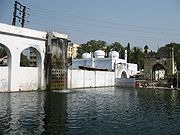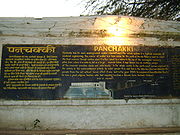
Panchakki
Encyclopedia
Panchakki, also called Nagari , is an abugida alphabet of India and Nepal...
: पानचक्की) also known as the water mill, takes its name from the mill which used to grind grain for the pilgrims. This monument located in Aurangabad, Maharastra, displays the scientific thought process put in medieval Indian architecture. It was designed to generate energy via water brought down form a spring on a mountain. The building, attached to the dargah of Baba Shah Musafir a Sufi saint is located in a garden near the Mahmud Darvaza
Gates in Aurangabad, Maharashtra
One of the things that makes Aurangabad stand out from the several other medieval cities in India were its 52 "gates", each of which have a local history or had individuals linked with them...
and consist of a mosque, a madrissa, a kacheri, a minister's house, a sarai and houses for zananas.

History

Dargah
A Dargah is a Sufi shrine built over the grave of a revered religious figure, often a Sufi saint. Local Muslims visit the shrine known as . Dargahs are often associated with Sufi meeting rooms and hostels, known as khanqah...
complex (including Panchakki) were erected by Turktaz Khan, a noble on the staff of Nizam-ul-Mulk Asaf Jah
Qamar-ud-din Khan, Asaf Jah I
Mir Qamar-ud-din Khan Siddiqi was a Mughal nobleman the founder of the Asaf Jahi dynasty. He established the Hyderabad state, and ruled it from 1720 to 1748...
in about 1695 A. D. The oblong reservoir in front of the mosque and fountains were added 20 years later by Jamil Beg Khan. Dating back to the 17th century, this ingenious water mill was designed to use the energy generated by flowing water from a nearby spring to turn the large grinding stones of the flourmill. Shah Mosafar died in Hijri
Islamic calendar
The Hijri calendar , also known as the Muslim calendar or Islamic calendar , is a lunar calendar consisting of 12 lunar months in a year of 354 or 355 days. It is used to date events in many Muslim countries , and used by Muslims everywhere to determine the proper day on which to celebrate Islamic...
1110. This water mill was used to grind grain for the pilgrims and disciples of saints as well as for the troops of the garrison.
Operation
The water-mill is kept fed with sufficient water by an underground conduit, which commences from a well just above the junction of the Harsul river with a tributary stream eight kilometers away. This water-pipe after crossing the tributary stream near its confluence with Harsul proceeds to the Panchakki reservoir. The arrangement is such that the water is made to fall in the Panchakki cistern from quite a height in order to generate the necessary power to drive the mill. The cistern in front of the mosque whose bottom forms the roof of a spacious hall. The cool chambers of the hall is used during the summers by pilgrims, and is about 164' X 31' ornamented with fountains, . The excess of water is let in the Kham river.A fine view of the Kham river can be had from the windows of this hall. There is also a cenotaph to the spiritual preceptor of Baba Musafir Shah and a tomb to his disciple Baba Shah Mahmood and a few other graves. A huge banyan
Banyan
A banyan is a fig that starts its life as an epiphyte when its seeds germinate in the cracks and crevices on a host tree...
tree on the southern margin of the reservoir provides shade and adds beauty to the whole scene. In the North-West corner, adjacent to the cistern is the water mill driven entirely by water power. It is said that in the olden days, grain could be ground by zero physical effort.
The country here exhibits one of the most picturesque landscapes about Aurangabad. The Kaula nala skirts the garden, and is first crossed by an old bridge with pointed arches and then by a second bridge which spans it lower down. The walls of Begampura are to the right and the city walls are to the left, while Shah Musafir's garden is between the latter and the river bank. The garden walls descend down to the bed of the nala; and the dargah and the accompanying buildings, with the cisterns and the fountains that are interspersed, blend picturesquely with the garden vegetation.
Recent
An 18th century library, housing manuscripts and a number of precious books has been reopened after 70 years here (Aurangabad). The library treasured about 100,000 books and writing pieces till Indian independence (1947). However, it was closed down in 1970s due to administrative reasons due to which many of the library books were shifted to Hyderabad. The library presently houses 2,500 books on various subjects related to history, law, medicine, SufismSufism
Sufism or ' is defined by its adherents as the inner, mystical dimension of Islam. A practitioner of this tradition is generally known as a '...
, religion and philosophy in Arabic, penned by philosophers, saints and scholars in Urdu
Urdu
Urdu is a register of the Hindustani language that is identified with Muslims in South Asia. It belongs to the Indo-European family. Urdu is the national language and lingua franca of Pakistan. It is also widely spoken in some regions of India, where it is one of the 22 scheduled languages and an...
and Persian language
Persian language
Persian is an Iranian language within the Indo-Iranian branch of the Indo-European languages. It is primarily spoken in Iran, Afghanistan, Tajikistan and countries which historically came under Persian influence...
Panchakki also houses the headquarters of the Wakf
Waqf
A waqf also spelled wakf formally known as wakf-alal-aulad is an inalienable religious endowment in Islamic law, typically denoting a building or plot of land for Muslim religious or charitable purposes. The donated assets are held by a charitable trust...
board of Maharashtra
Maharashtra
Maharashtra is a state located in India. It is the second most populous after Uttar Pradesh and third largest state by area in India...
.
See also
- Sufi Saints of AurangabadSufi Saints of AurangabadAurangabad furnished a genial soil for the spread of the religion of the Prophet, and was the centre of great missionary movements in the 8th century of the Hijri. The district is home to the earliest of Sufi saints of the Deccan. The town of Khuldabad contains the shrines of the most famous saints...
- Aurangabad
- Aurangabad Water System

